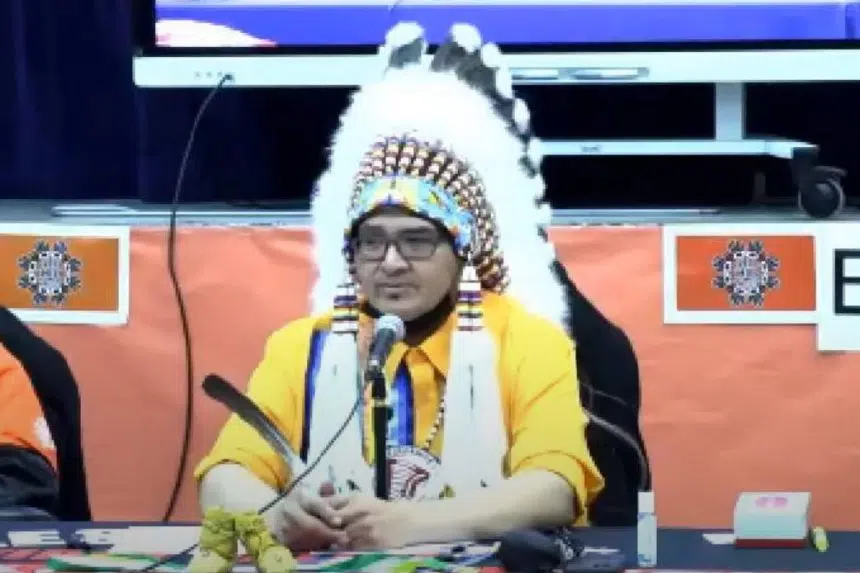The ceremony in the Keeseekoose school gym opened with a flag song and an honour song, preceded that morning by a pipe ceremony — all to set the stage for the heartbreaking news to be publicly announced.
On Tuesday, the Keeseekoose First Nation said 54 unmarked graves had been discovered on the sites of two former Indian Residential Schools on the First Nation about 285 kilometres northeast of Regina.
The graves were found after a search using ground-penetrating radar.
Most in the gymnasium wore orange shirts and sweaters, some under blazers or over ribbon skirts. The ceremony was filled with sadness but also resolve to reveal the truth and to heal.
Chief Lee Kitchemonia spoke to the room, explaining he had lived in the community his entire life and had heard the stories from his mother and father. He said he thinks about all those children who went to school.
“That’s what it really boils down to is seeing your kid leave your house in the morning time (and) not realizing that you’ll never, ever see your child again for as long as you live (and) not knowing any answers to where those children have gone. All you know is that they’re gone to school and they’ve never returned,” said Kitchemonia.
“I can’t imagine what those parents and grandparents would have felt like. All I know is that it must have been a hurt that nobody could ever imagine.”
Kitchemonia said he didn’t know if this discovery would be the end of finding graves, but it does open the door for more questions.
“It’s going to be a very tough time for our community, knowing that we had unmarked graves in our community (and) in our common areas that we drive every day (or) that we walk every day. We passed by them, never realizing that there were graves,” he said.
The most hurtful part to Kitchemonia is how the graves were hidden.
“Who does that?” he asked.
Kitchemonia also asked who is going to be held accountable for it because, he said, these could potentially be murdered children.
“We don’t know any of these answers, so we need to fight for these records to see what happened to see who these graves belong to; they could be our aunts or uncles or grandfathers, things like that. They’re vanished off the face of this earth, never to be seen again,” said Kitchemonia.
The two residential schools on the First Nation were Fort Pelly School, which was established in 1895 and was open for 18 years, and St. Philip’s School, which was open from 1928 to 1969.
The areas searched with ground-penetrating radar were identified by school survivors and knowledge-keepers in the community, according to Ted Quewezance — the project manager, a former leader in the community and a survivor himself.
“The ground-penetrating radar simply validated our oral history,” said Quewezance.
In the announcement, maps were unveiled on the walls of the gym, showing the 42 hits found at the Fort Pelly School site and the 12 found at the St. Philip’s School site.
“The historical record of Keeseekoose, the oral tradition, includes what survivors directly experienced, what survivors saw, what survivors heard … These stories have been part of our truth-telling for the last 125 years. We all knew that we would find gravesites,” explained Quewezance.
When it came to the students who went missing, those who never came home, Quewezance said the stories usually fell on deaf ears.
“It was not that they could not hear but they did not believe our survivors. Many Canadians still cannot believe that a human being could treat another human being, especially a child, like the way we were treated,” said Quewezance, his voice filling with emotion.
“I can tell you first-hand that these things happened, to myself and every member of my family, and many families in our communities.”
Quewezance said survivors want closure and healing.
“If anything is going to carry us as we move forward, it’s going to be truth-telling and conciliation — not reconciliation, but conciliation,” he said.
All kinds of representatives spoke to those assembled in person and online: Chiefs of the FSIN and AFN, the federal minister of Crown-Indigenous Relations, the lieutenant governor, several elders and residential school survivors from the community. A representative of the RCMP was there as well in their red serge but didn’t speak.
Mary Culbertson, the first woman treaty commissioner in Saskatchewan, spoke to the group. She spoke about growing up on the First Nation and hearing stories about the school.
She said kids knew the places they couldn’t play and knew not to look outside at night because they were always scared of where the playground was.
Archbishop Donald J. Bolen of the Regina Archdiocese spoke and gave an apology, saying the church is profoundly sorry for the role it played in the pain and abuse that went on at residential schools and the intergenerational trauma it’s still causing.
Quewezance explained the community is working on trying to figure out who the graves belong to, and the graves will now be maintained by the community. They’re also working with the school to create a virtual museum so the records they find and put together can educate.
According to The National Centre for Truth and Reconciliation, St. Philip’s Residential School had a widespread problem with sexual and physical abuse, which led to the dismissal of a school supervisor over the mistreatment of students.
The centre has an official record of two student deaths at St. Philip’s and two at Fort Pelly.
Similar searches have gone on across Saskatchewan since the remains of 215 children were found in unmarked graves at the former site of a residential school in Kamloops last summer.
A search using ground-penetrating radar at the Cowessess First Nation in June of last year found 751 unmarked graves at the site of the former Marieval Indian Residential School.
— With files by The Canadian Press











